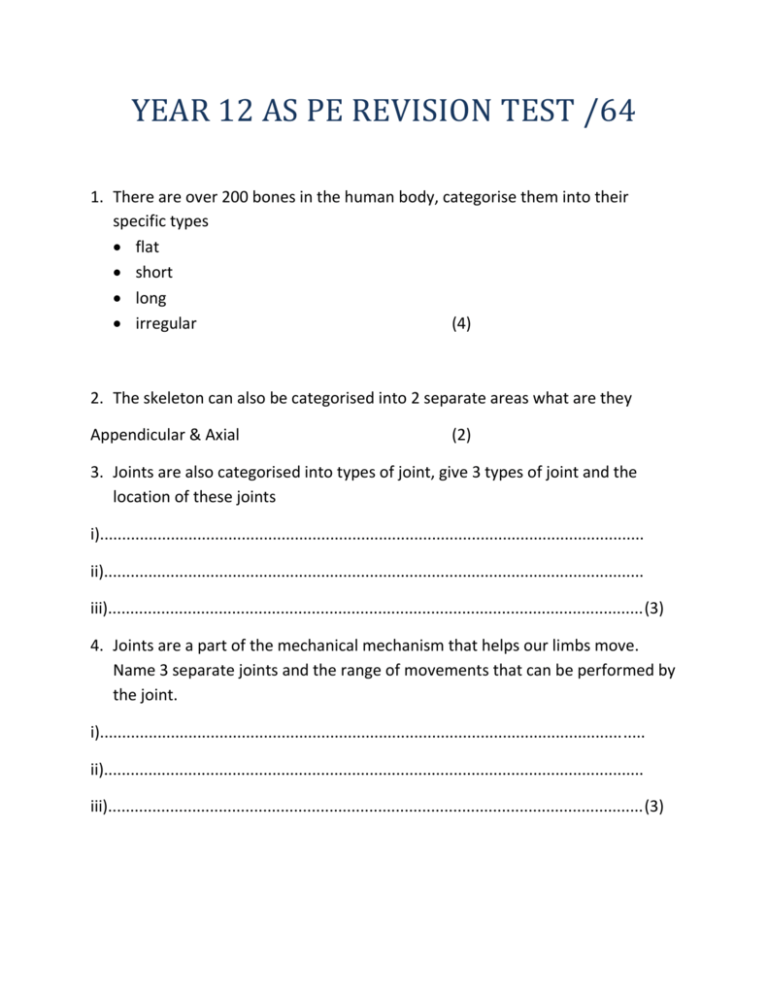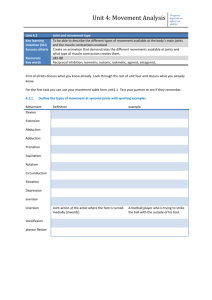Revision Test Answers
advertisement

YEAR 12 AS PE REVISION TEST /64 1. There are over 200 bones in the human body, categorise them into their specific types flat short long irregular (4) 2. The skeleton can also be categorised into 2 separate areas what are they Appendicular & Axial (2) 3. Joints are also categorised into types of joint, give 3 types of joint and the location of these joints i)........................................................................................................................... ii).......................................................................................................................... iii).........................................................................................................................(3) 4. Joints are a part of the mechanical mechanism that helps our limbs move. Name 3 separate joints and the range of movements that can be performed by the joint. i)........................................................................................................................... ii).......................................................................................................................... iii).........................................................................................................................(3) 5. Muscles attached to bones are what allows our limbs to move, what are the 3 types of muscle tissue Cardiac Skeletal / voluntary / striped Smooth / involuntary (3) 6. Skeletal muscle otherwise known as striped muscle tissue is the most common form of muscle tissue in the body what are the 3 types of muscle contraction, remember 1 contraction is sub-divided into 2 parts isometric Isokinetic isotonic – eccentric / concentric (3) 7. Using the press up and the phases of the movement of 1 press up describe how all 3 main types of muscle contraction can be demonstrated During the upward phase bicep brachii contracts and shortens and flexes elbow performing concentric contraction During downward phase tricep brachii under tension lengthens and extends elbow performing eccentric contraction If elbow held at 90* bicep under tension but no movement therefore isometric contraction (6) 8. A basketball player is performing a free throw shot analyse the movement of the throwing arm and the legs during the execution phase of the shot ............................................................................................................................... ............................................................................................................................... ............................................................................................................................... ............................................................................................................................... ............................................................................................................................... ............................................................................................................................... ............................................................................................................................... ............................................................................................................................... ............................................................................................................................... ............................................................................................................................... ............................................................................................................................... ............................................................................................................................... ...............................................................................................................................(6) 9. Within the muscle tissue genetics determines the make up of the muscle fibres identify the 3 muscle fibre types with an example from sport of who would like to have these 3 types of muscle tissue in greater quantities i) slow twitch – marathon runner ii) fast twitch oxidative – 1500m runner iii) fast twitch glycolytic – 100m sprinter (3) 10. Complete the following table: CHARACTERISTIC TYPE 1 TYPE IIA TYPE IIB CONTRACTION SPEED SLOW FAST FAST LOW/SLOW FAST VERY FAST GLYCOGEN STORES LOW MEDIUM/HIGH VERY HIGH AEROBIC CAPACITY HIGH MEDIUM LOW ANAEROBIC CAPACITY LOW MEDIUM HIGH FATIGUABILITY (15) 11. Sliding filament theory is looking at how voluntary muscle tissue contracts explain what this theory is in greater detail. Each muscle fibre is made up of lots of myofibrils. Each myofibril is broken up into sections called sarcomeres. When the muscle is relaxed the sarcomeres are at their furthest apart this is called the ‘Z’ lines. When the muscle contracts the Z lines move closer together. This is sliding filament theory. The actin at each end of the sarcomere is pulled closer together when actin is apart this ‘H zone’ is clear until they contract and the H zone disappears. Myosin heads attach and pulls on the actin bringing everything closer together therefore contracting the muscle. (6) 12.Draw a motor neurone indicating the electrical current pathway (5) 13.Draw a graph to illustrate how muscle fibre types are recruited to depending on the intensity of the exercise 14.Why would a 100meter sprinter not necessarily need to perform a warm up Because the 100m is completed in around 10 seconds this will mean the body does not need oxygen to perform the activity therefore is anaerobic. A warm up is only need to prepare the body for aerobic activity 15.Give 3 effects a warm up has on the body i) Increase body temperature ii) Blood viscosity reduces iii) Dilates capillaries iv) Enhances enzyme activity for energy production 16.Why is it advised that after prolonged exercise a cool down is performed Elevated heart rate allows the body to remove lactic acid more efficiently More oxygen can get to the muscle cells to resynthesize ATP Prevents blood pooling Whilst muscles and joints are warm and free moving an ideal time to improve flexibility





